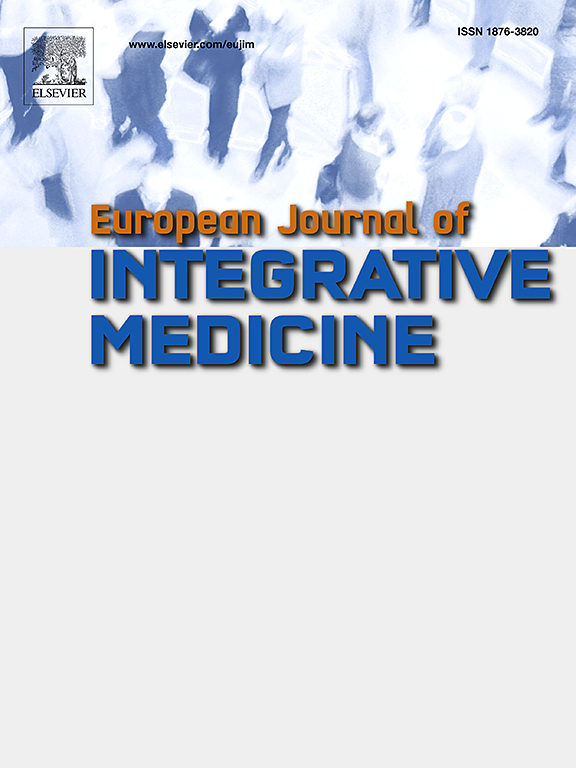Effectiveness and safety of Qianjinweijing decoction in the treatment of bronchiectasis: A systematic review and meta-analysis
IF 1.9
4区 医学
Q3 INTEGRATIVE & COMPLEMENTARY MEDICINE
引用次数: 0
Abstract
Introduction
Bronchiectasis is a chronic inflammatory airway disease marked by permanent dilation of the bronchi, recurrent infections, and associated complications. The traditional Chinese medicine Qianjinweijing Decoction (QJWJ) has shown promising results in bronchiectasis treatment with few side effects. However, there is a lack of recent comprehensive research evaluating its effectiveness. This review aims to examine the effectiveness and safety of QJWJ in treating bronchiectasis.
Methods
We searched 7 databases including China National Knowledge Infrastructure (CNKI), Wanfang Database, VIP Chinese Science Database, China Biology Medicine Disc (Sinomed), PubMed, Embase, and Cochrane Library, for relevant randomized controlled trials (RCTs) until May 2023, in both Chinese and English. Two researchers conducted a comprehensive review of literature, extracting data based on predefined criteria. The risk of bias was assessed using the Cochrane Collaboration tool, and meta-analysis was performed using RevMan 5.4.1 and RStudio software. Quality of evidence was evaluated using GRADEpro (V3.6.) software.
Results
This review analysed 35 studies with 2609 patients. The QJWJ group consisted of 1318 patients, while the routine pharmacotherapy (RP) group had 1291 patients. Combining QJWJ and RP in bronchiectasis treatment showed better with clinical effectiveness [risk ratio (RR)=1.17, 95 % confidence interval (CI) (1.13, 1.21), P < 0.00001], the percentage of forced expiratory volume in the first second to the predicted value (FEV1 %) [mean difference (MD)=3.52, 95 % CI (1.48, 5.55), P = 0.0007], the ratio of forced expiratory volume to forced vital capacity in the first second (FEV1/FVC) [MD=6.62, 95 % CI (1.52, 11.72), P = 0.01], peak expiratory flow rate (PEFR) [MD=7.14, 95 % CI (5.15, 9.12), P < 0.00001], white blood cell count (WBC) [MD=-1.42, 95 % CI (-2.53, -0.31), P = 0.01], c-reactive protein (CRP) [MD=-7.2, 95 % CI (-9.3, -5.1), P < 0.00001], and the procalcitonin (PCT) [standardized mean difference (SMD)=-1.39, 95 % CI (-2.02, -0.76), P < 0.0001], without increasing the incidence of adverse reactions [RR=0.79, 95 % CI (0.44, 1.42), P = 0.43]. QJWJ alone also significantly improved bronchiectasis treatment, enhanced clinical effectiveness [RR=1.19, 95 % CI (1.04, 1.36), P = 0.010], FEV1 % [MD=7.09, 95 % CI (4.5, 9.68), P < 0.00001], and reduced WBC [MD=-2.7, 95 % CI (-3.7, -1.7), P < 0.00001], CRP [MD=-4.22, 95 % CI (-55.32, -3.12), P < 0.00001], without increasing the incidence of adverse reactions [RR=0.20, 95 % CI (0.01, 4.06), P = 0.29].
Conclusion
Evidence suggested that QJWJ, used alone or with RP, notably improved bronchiectasis treatment outcomes, enhanced lung function and reduced inflammation without raising adverse reaction risks. Yet, further support from high-quality, large-sample RCTs is needed to strengthen this conclusion.
千金味精煎剂治疗支气管扩张症的有效性和安全性:系统回顾和荟萃分析
导言支气管扩张症是一种慢性气道炎症性疾病,以支气管永久性扩张、反复感染和相关并发症为特征。传统中药千金微晶煎剂(QJWJ)在治疗支气管扩张症方面疗效显著,且副作用小。然而,近期缺乏对其疗效进行全面评估的研究。方法我们检索了7个数据库,包括中国国家知识基础设施(CNKI)、万方数据库、VIP中国科学数据库、中国生物医学文献数据库(Sinomed)、PubMed、Embase和Cochrane图书馆,寻找截至2023年5月的相关中英文随机对照试验(RCT)。两名研究人员对文献进行了全面审查,并根据预先确定的标准提取数据。使用 Cochrane 协作工具评估了偏倚风险,并使用 RevMan 5.4.1 和 RStudio 软件进行了荟萃分析。使用 GRADEpro (V3.6.) 软件对证据质量进行了评估。QJWJ组有1318名患者,而常规药物治疗(RP)组有1291名患者。将 QJWJ 和 RP 联合用于支气管扩张症治疗显示出更好的临床疗效[风险比(RR)=1.17,95 % 置信区间(CI)(1.13,1.21),P < 0.00001]、第一秒用力呼气容积占预测值的百分比(FEV1 %)[平均差(MD)=3.52,95 % CI(1.48,5.55),P = 0.0007]、第一秒用力呼气容积与用力肺活量之比(FEV1/FVC)[MD=6.62,95 % CI(1.52,11.72),P = 0.01]、呼气峰流速(PEFR)[MD=7.14,95 % CI(5.15,9.12),P <;0.00001]、白细胞计数(WBC)[MD=-1.42,95 % CI(-2.53,-0.31),P = 0.01]、c 反应蛋白(CRP)[MD=-7.2,95 % CI(-9.3,-5.1),P< 0.00001]、降钙素原(PCT)[标准化平均差(SMD)=-1.39,95 % CI(-2.02,-0.76),P< 0.0001],同时不增加不良反应的发生率[RR=0.79,95 % CI(0.44,1.42),P=0.43]。单用 QJWJ 也能明显改善支气管扩张症的治疗,提高临床疗效 [RR=1.19, 95 % CI (1.04, 1.36), P = 0.010]、FEV1 % [MD=7.09,95 % CI(4.5,9.68),P <;0.00001],降低WBC[MD=-2.7,95 % CI(-3.7,-1.7),P <;0.00001]、CRP[MD=-4.22,95 % CI(-55.32,-3.12),P <;0.结论有证据表明,单独使用或与 RP 一起使用 QJWJ 可显著改善支气管扩张症的治疗效果,增强肺功能,减轻炎症反应,而不会增加不良反应风险。然而,要加强这一结论,还需要高质量、大样本 RCT 的进一步支持。
本文章由计算机程序翻译,如有差异,请以英文原文为准。
求助全文
约1分钟内获得全文
求助全文
来源期刊

European Journal of Integrative Medicine
INTEGRATIVE & COMPLEMENTARY MEDICINE-
CiteScore
4.70
自引率
4.00%
发文量
102
审稿时长
33 days
期刊介绍:
The European Journal of Integrative Medicine (EuJIM) considers manuscripts from a wide range of complementary and integrative health care disciplines, with a particular focus on whole systems approaches, public health, self management and traditional medical systems. The journal strives to connect conventional medicine and evidence based complementary medicine. We encourage submissions reporting research with relevance for integrative clinical practice and interprofessional education.
EuJIM aims to be of interest to both conventional and integrative audiences, including healthcare practitioners, researchers, health care organisations, educationalists, and all those who seek objective and critical information on integrative medicine. To achieve this aim EuJIM provides an innovative international and interdisciplinary platform linking researchers and clinicians.
The journal focuses primarily on original research articles including systematic reviews, randomized controlled trials, other clinical studies, qualitative, observational and epidemiological studies. In addition we welcome short reviews, opinion articles and contributions relating to health services and policy, health economics and psychology.
 求助内容:
求助内容: 应助结果提醒方式:
应助结果提醒方式:


